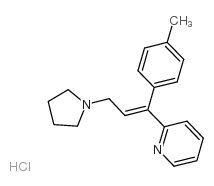550-70-9
| Name | triprolidine hydrochloride (anh.) |
|---|---|
| Synonyms |
EINECS 208-985-0
MFCD00039044 Triprolidine Hydrochloride Triprolidine HCl |
| Description | Triprolidine is an oral active, first-generation histamine H1-receptor antagonist. Triprolidine can be used for the research of allergic rhinitis. triprolidine exhibits spinal motor and sensory block in rats[1][2][3]. |
|---|---|
| Related Catalog | |
| Target |
H1 Receptor |
| In Vivo | Triprolidine (292.81-1467.20 μg/kg; intrathecal injection) produces a dose-dependent effect of spinal motor and sensory block in rats[3]. Animal Model: Male Sprague-Dawley rat (300-350 g)[3] Dosage: 292.81 μg/kg, 488.02 μg/kg, 733.60μg/kg, 1098.83 μg/kg, 1467.20 μg/kg Administration: Intrathecal injection Result: Elicited a dose-dependent spinal block. |
| References |
| Density | 1.061g/cm3 |
|---|---|
| Boiling Point | 435.4ºC at 760mmHg |
| Melting Point | 59-61ºC |
| Molecular Formula | C19H23ClN2 |
| Molecular Weight | 314.85200 |
| Flash Point | 217.1ºC |
| Exact Mass | 314.15500 |
| PSA | 16.13000 |
| LogP | 4.65740 |
| Storage condition | 2-8°C |
CHEMICAL IDENTIFICATION
HEALTH HAZARD DATAACUTE TOXICITY DATA
|
| Hazard Codes | Xn |
|---|---|
| Risk Phrases | 22-36/37/38 |
| Safety Phrases | 26-36 |
| RIDADR | UN 3249 |
| WGK Germany | 3 |
| RTECS | UT7658000 |
| Packaging Group | III |
| Hazard Class | 6.1(b) |
| HS Code | 2933990090 |
|
~51% 
550-70-9 |
| Literature: HIKAL LIMITED Patent: WO2009/84035 A1, 2009 ; Location in patent: Page/Page column 11-12 ; |
|
~% 
550-70-9 |
| Literature: WO2007/141803 A2, ; Page/Page column 6-7 ; |
| Precursor 1 | |
|---|---|
| DownStream 0 | |
| HS Code | 2933990090 |
|---|---|
| Summary | 2933990090. heterocyclic compounds with nitrogen hetero-atom(s) only. VAT:17.0%. Tax rebate rate:13.0%. . MFN tariff:6.5%. General tariff:20.0% |

